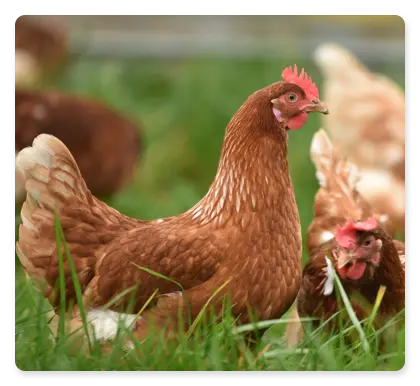Avian Influenza Virus (AIV) is a highly mutable virus belonging to the genus Influenza A virus of the family Orthomyxoviridae.The H5 antigen is an important serotype of avian influenza viruses, especially subtypes such as H5N1 and H5N6, which are of great concern because of their high pathogenicity in poultry and humans.
Characteristics and antigenicity
Characteristics
Genomic structure:
Avian influenza viruses are RNA viruses whose genome consists of eight single-stranded negative-stranded RNA segments, each encoding one or more proteins.
The H5 antigen mainly involves the Hemagglutinin (HA) protein, which is responsible for viral adhesion and entry into host cells.
Hemagglutinin: The HA protein is a glycoprotein on the surface of the virus and is classified into 16 serotypes (H1-H16), of which H5 is one. The HA protein is responsible for binding to a receptor on the surface of the host cell that mediates the entry of the virus into the cell.
Antigenic variation: Avian influenza viruses are prone to antigenic drift and antigenic switching, leading to the emergence of new subtypes and epidemics. of the H5 subtypes, H5N1 is one of the most representative and pathogenic.
Antigenicity
Immunogenicity: The H5 antigen is highly immunogenic and induces the production of neutralising antibodies against the HA protein. Neutralising antibodies prevent the virus from entering host cells, thus providing immune protection.
Cross-reactivity: There may be some cross-immunity between different H5 subtypes, but usually the cross-protection is limited. Immune escape is more prevalent due to antigenic variation, posing a challenge to vaccine development.
Clinical symptoms and disease severity
Symptoms in poultry
Highly pathogenic avian influenza (HPAI):
Acute onset: onset within a short period of time after infection, with a rapid course of the disease.
High mortality: Mortality rate up to 90-100%, especially in chickens and turkeys.
Typical symptoms: depression, loss of appetite, respiratory distress, dysentery, haemorrhage and oedema of the crown and meat beard.
Low Pathogenic Avian Influenza (LPAI):
Mild symptoms: mild respiratory symptoms such as coughing, sneezing, tearing.
Decrease in egg production: significant decrease in egg production in infected hens.
Human symptoms
Flu-like symptoms:
Fever, cough, sore throat, muscle aches, headache.
Severe symptoms:
Severe pneumonia, acute respiratory distress syndrome, multiple organ failure.
Rapid deterioration and high mortality in highly pathogenic H5 subtype infections.
Routes of transmission
Direct contact: poultry-to-poultry transmission: spread through direct contact with infected poultry or their secretions and excretions.
Human-poultry contact: Humans are infected with the virus through direct contact with infected poultry or their secretions and excretions.
Environmental transmission: the virus can be transmitted indirectly through contaminated water, feed, utensils, etc.
Airborne transmission: The virus can be transmitted through airborne droplets, especially in confined and poorly ventilated environments.
Clinical diagnosis
Observation of clinical symptoms: Preliminary diagnosis based on typical symptoms in poultry or humans.
Laboratory tests: PCR: Detection of viral RNA in respiratory samples by reverse transcription PCR (RT-PCR) is a rapid and sensitive test.
Virus isolation: Virus is isolated from diseased birds or patient samples for culture and identification of the virus.
Serological testing: Detection of antibodies in serum using haemagglutination inhibition (HI) or enzyme-linked immunosorbent assay (ELISA) for assessment of infection and immune response.
Rapid diagnostic reagents: Use of rapid antigen detection kits for initial screening, but laboratory confirmation is required.
Preventive measures
Vaccination: Vaccinate poultry with avian influenza vaccine against the H5 subtype, especially in high-risk areas. Regularly update the vaccine strain to cope with antigenic variation of the virus.
Biosecurity measures: Strictly implement biosecurity measures including quarantine of newly introduced poultry, disinfection of personnel and equipment, and restriction of entry and exit of personnel and vehicles to poultry farms.
Regularly monitor the disease situation inside and outside the poultry farm and take timely preventive and control measures.
Management Measures
All-in-all-out: Adopt an all-in-all-out feeding management mode to avoid mixing of different batches of poultry. It helps to reduce the spread of virus among poultry.
Isolation and quarantine: newly introduced poultry should be isolated and quarantined to ensure that they are not infected with H5 subtype virus. Regular health checks should be conducted to detect and treat infected poultry in a timely manner.
Personnel training: Raise awareness and preventive and control skills of keepers and veterinarians on H5 subtype avian influenza.
Therapeutic Measures
There is no specific drug against H5 subtype avian influenza virus infection. The mainstay of treatment is symptomatic, providing supportive care and proper nutrition.
The use of antiviral drugs such as oseltamivir (Tamiflu) and zanamivir (Relenza) may help to alleviate the symptoms but have limited effect.
Control measures
Culling of infected poultry: Rapidly cull infected and suspected infected poultry to prevent spread of the virus. Thoroughly clean and disinfect contaminated environment, equipment and utensils.
Strict control of poultry trade: Restrict or prohibit the trade of poultry and poultry products in areas affected by the outbreak to prevent the spread of the virus.
Avian Influenza Virus H5 Antigen Rapid Test
Antigenne has developed the Avian Influenza Virus H5 Antigen Rapid Test, which is a fast, easy-to-use and highly accurate test that can help users to detect relevant viral infections.













